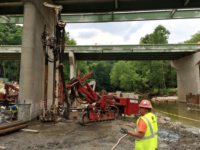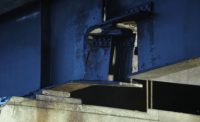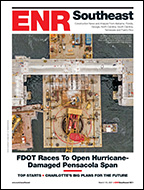
Repairs to an unstable pier supporting an Interstate-65 bridge near Lafayette, Ind., were completed over Labor Day weekend, allowing the Indiana Dept. of Transportation to reopen a 37-mile section of the highway's northbound lanes that had been closed to traffic for more than four weeks.
The 394-ft, five-span continuous steel multibeam-girder bridge across Wildcat Creek was shut down on Aug. 7, when pile-driving being performed as part of a widening project apparently caused the structure's 43-ft-tall, 10.5-ft-wide middle pier to rotate and settle as much as 10 in. into the riverbank. An investigation led by INDOT, the Federal Highway Administration and contractor Walsh Construction Co. determined the newly driven piles had penetrated the site's watertight, granular soils and pierced an underlying sandy layer with groundwater under pressure.
Nicholson Construction Co., Cuddy, Pa., worked as subcontractor to Walsh to develop a design-build solution of micropiles to transmit loads to dense granular soils at depth as well as low-mobility grout to fill voids and densify the upper subsurface layer.
"These methods were selected specifically to deal with the artesian groundwater condition of about 15 feet of head-above-ground surface," says Rick Deschamps, vice president of engineering at Nicholson.
At each of the 12 micropile locations, Nicholson first cored through the pier's original 2.5-ft-thick footing and installed 95/8-in.-dia casings to 15 ft below grade, approximately 5 ft above the sandy soils. After grouting the casings, the 7-in.-dia micropiles were drilled to a depth of 70 ft below grade - 56 ft below the pier footing's original elevation.
Walsh Construction completed the foundation repair with a 4.5-ft-thick cast-in-place cap to transfer pier loads to the micropiles. Then, the superstructure was jacked up to its original height, with steel H-piles and metal shims installed alongside the pier as a temporary support enhancement.
"We're currently reevaluating the widening design for the bridge to determine what changes, if any, will be made to the pier," says Anne Rearick, director of bridges for INDOT. Walsh and Purdue University researchers have installed inclinometers on the piers of both the north- and southbound bridges to detect any movement, while strain gauges will measure stress on the steel girders as the traffic loads change.
Still to be determined are the final cost of the repairs and who will be responsible for them, as well as the pier incident's effect on the overall two-year, $82.8-million project, which began this past April to expand a seven-mile stretch of I-65 to six lanes from four.
"With the northbound lanes closed, we were able to move ahead on other tasks," including widening of a nearby bridge, paving and inspections, Rearick says.





Post a comment to this article
Report Abusive Comment